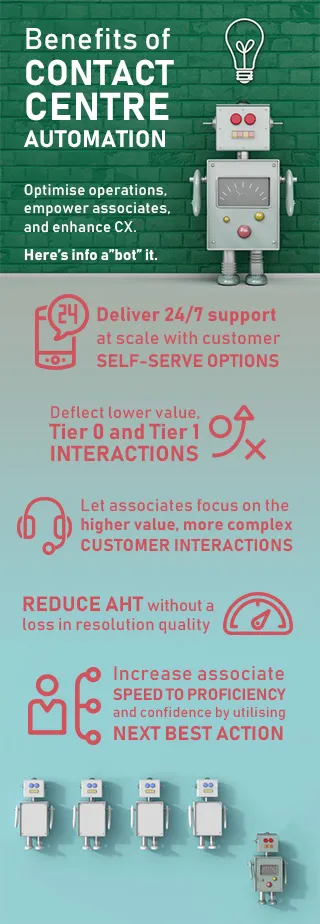For 2020, the implementation of contact centre automation is accelerating, so it is essential for companies to implement best practices, or risk falling behind the competition.
Technological advances in robotic process automation (RPA), AI, and machine learning (ML) are literally changing the face of customer care. However, just because you can automate something in the contact centre doesn’t mean you should. To know which tasks to turn over to artificial intelligence and a machine is a challenge.
In this article, we explain the most important approach to successful contact centre automation, outline some of the main types of contact centre automation tools being implemented in contact centres, and discuss the benefits of an optimised balance between humans and AI in your CX automation approach. At the end of the article, we also include a series of downloadable cheat sheets, which take a lighthearted look at the pros and cons of different contact centre automation tools.
Intelligent automation in the contact centre
In our experience, the most important contact centre automation best practice is to balance core service goals and KPIs with automation to continually improve customer experiences and operational efficiency. To optimise omnichannel services for your customers and employees, you must know when to utilise human interaction from live agents and when to deploy AI powered virtual assistants and automation processes. Finding this perfect balance in your contact centre automation approach is what we call “Thoughtful Automation.”
Intelligent automation in the contact centre serves several purposes beyond just cost containment. For example, the most commonly discussed application is to automate simple, time consuming. repetitive tasks. This helps reduce overall handle time and allows contact centre agents to be available for more complex customer centric interactions. But that is just the start of where automation can improve your contact centre operations. Automation can be used behind the scenes to assist associates, helping them make better, quicker decisions. It can also be used to scale up digital service knowledge capture, codification, and application, and to enhance customer service quality over the long term.
Overall, contact centre automation tools are primarily used in the following ways:
Chatbots and active listening such as natural language processing (NLP) and natural language understanding (NLU) fuel natural language generation (NLG) and conversational UI tool via chatbots or voice assistants during customer interactions.
Robotic process automation (RPA) replaces tier 0 and other simple interactions that are task-oriented and programmable. Rather than deploying individual bots for each task, a digital worker factory model trains a single intelligent virtual agent (IVA) to handle multiple use cases, and integrate that IVA into multiple channels for a single, consistent, omnichannel experience.
Statistical machine learning continuously improves systems by using algorithms to mine interaction data to identify patterns in associate activity, resolutions, and customer feedback from each interaction. Operations can become faster, more efficient, and more effective the longer ML is in place doing tasks.
Deep learning neural networks take machine learning to the next level by continually learning and drawing conclusions in ways that mimic the human brain. They are starting to be employed in the contact centre to classify, learn from, and improve conversations with consumers, but also with associates and the systems they work with.
Examples of effective contact centre automation implementations
All of the above contact centre automation tools provide strengths and weaknesses to improving customer experience, employee experience, and contact centre operations. By embracing what automation does well, while also recognising its limitations, the perfect balance of human and AI can be established in the contact centre. It is a closed loop system in which humans help AI to help humans, as automation tools bridge the manual, human-intensive gap with AI-enhanced systems of intelligence.
By thinking of how contact centres operate, numerous opportunities for thoughtful contact centre and call centre automation emerge. Customer engagement occurs over many channels—voice, web, mobile, chat, social, and in-person. They are looking for resolution of issues, and provide customer information to the company in the form of speech, text, video, or social data. Associates interact with customers in these channels, using internal systems of record to get information to resolve issues, such as CRM, ERP, knowledgebase, billing, etc. The human associate must work manually within the systems to find what they need, then communicate back to customers.
Below are three specific examples of effective contact centre and CX automation that balance the best of what humans and AI have to offer.

Customer assist: Automatically connects customers to the systems of record via chatbots and voice assistants in whatever engagement channel customers use. It removes communication channel barriers, speeds up resolution, and eliminates the manual associate responsibility to resolve issues. It uses automated intelligence so customers can act autonomously, self-serve, and interact directly with the internal systems without human intervention.
For your contact centre operations, this can be beneficial by deflecting lower value Tier 0 and Tier 1 interactions, while also delivering 24/7 customer support at scale. At the same time, the faster resolution times chatbots can accomplish for less complex issues can help improve overall contact centre KPIs such as average handle and customer satisfaction ratings.
Machine learning automation models: Expert associates train the AI about what interactions are best to automate and what to keep under human control. This leverages the institutional knowledge of the contact centre staff to augment services in new, innovative ways, whilst maintaining the quality and tone of traditional interactions. Employees are needed to help the AI learn, reason, and optimise different types of customer interactions.
In the competitive contact centre space, employees are a company’s differentiator. They are brand ambassadors and often have the “secret sauce” of what makes a customer interaction successful. It could be a certain inflection, phrasing, or cadence, or knowing when to push and when to pull back. These are all insights that human associates can help teach the AI systems to be more thoughtful.
Associate assist: Use automation and AI behind the scenes to help associates. Connect them with the information in the systems of record more quickly and effectively. They can interpret information and data accessed in real time and scale to help customers resolve issues. The intelligence can serve associates the right information at the right time.
This thoughtful automation approach in the contact centre marries human intuition, creativity, and empathy with a computer’s brute-force ability to remember and calculate a staggering number of options and outcomes.
Benefits of contact centre automation
Adding an AI-enhanced system of intelligence to the contact centre provides a number of benefits. It redefines the nature of service value creation at speed and scale. Automation can be turned on when it’s needed, and turned off when it’s not. Surge events or unexpected issues can be more easily managed with a layer of automation and AI available.
AI also reshapes the transformation of customer experiences and establishes new service models. The stress on employees is reduced, and they can focus their attention on more customer centric issues. With the infrastructure in place, new channels can be added and new ways to serve customers can be considered. The knowledgebase is continuously updated, keeping employees up to date on how best to resolve issues.
Machine learning and AI can help firms identify patterns in interactions or analytics more easily than humans, for example, giving companies the ability to predict and develop proactive outreach based on service issues customers may not even be aware of. And advanced root cause analysis can lead to new products and services, or uncover opportunities to pursue new markets with enhanced service features, functions, and performance. The automation transformation in the contact centre also increases the demand to recruit, transition, and retool the service workforce with a focus of augmenting human work with smart machines that eliminate repetitive tasks through automation.
And perhaps most importantly, automation changes what success looks like in the contact centre. It moves the focus from handle time, calls per hours, other operational KPIs to outcome-based metrics like customer satisfaction, first contact resolution, and NPS. When bots handle the operations, there is no need to measure success on how “hard” the bot worked or how many interactions it facilitated. Instead, the focus can be put on how well the customer was served and if they came away from the interaction with a resolution.
The contact centre is swiftly moving from a cost centre to a channel of strategic customer engagement. Brand ambassadors are replacing “agents” to resolve issues and represent the brand promise in meaningful service interactions.
Intelligent automation applies the best of both humans and technology to develop and improve interactions for enterprises at scale. It combines the emotion and empathy that people possess with the speed and accuracy of digital tools. The result is a contact centre designed to operate quickly, accurately, and enable the fantastic customer experiences that had previously been out of reach.
Learn more about our contact centre automation best practices
We hope you enjoyed this article outlining some of the best practices for contact centre automation. So how can you put intelligent automation to work? Read more best practices and tactics in our strategy guide, How Contact Centre Automation is Transforming Customer Care. Discover why it’s important to create systems of intelligence to combine the best that humans and technology offers, and how to adapt a service workforce to AI transformation. The guide also includes customer and employee use cases of thoughtful contact centre automation in action.














